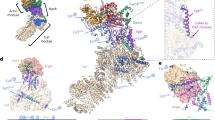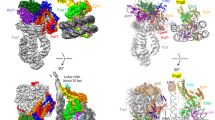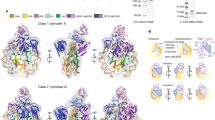Abstract
Histone acetylation and nucleosome remodeling regulate DNA damage repair, replication and transcription. Rtt109, a recently discovered histone acetyltransferase (HAT) from Saccharomyces cerevisiae, functions with the histone chaperone Asf1 to acetylate lysine K56 on histone H3 (H3K56), a modification associated with newly synthesized histones. In vitro analysis of Rtt109 revealed that Vps75, a Nap1 family histone chaperone, could also stimulate Rtt109-dependent acetylation of H3K56. However, the molecular function of the Rtt109–Vps75 complex remains elusive. Here we have probed the molecular functions of Vps75 and the Rtt109–Vps75 complex through biochemical, structural and genetic means. We find that Vps75 stimulates the kcat of histone acetylation by ∼100-fold relative to Rtt109 alone and enhances acetylation of K9 in the H3 histone tail. Consistent with the in vitro evidence, cells lacking Vps75 showed a substantial reduction (60%) in H3K9 acetylation during S phase. X-ray structural, biochemical and genetic analyses of Vps75 indicate a unique, structurally dynamic Nap1-like fold that suggests a potential mechanism of Vps75-dependent activation of Rtt109. Together, these data provide evidence for a multifunctional HAT–chaperone complex that acetylates histone H3 and deposits H3-H4 onto DNA, linking histone modification and nucleosome assembly.
This is a preview of subscription content, access via your institution
Access options
Subscribe to this journal
Receive 12 print issues and online access
$189.00 per year
only $15.75 per issue
Buy this article
- Purchase on Springer Link
- Instant access to full article PDF
Prices may be subject to local taxes which are calculated during checkout






Similar content being viewed by others
References
Shahbazian, M.D. & Grunstein, M. Functions of site-specific histone acetylation and deacetylation. Annu. Rev. Biochem. 76, 75–100 (2007).
Avvakumov, N. & Cote, J. The MYST family of histone acetyltransferases and their intimate links to cancer. Oncogene 26, 5395–5407 (2007).
Baker, S.P. & Grant, P.A. The SAGA continues: expanding the cellular role of a transcriptional co-activator complex. Oncogene 26, 5329–5340 (2007).
Yang, X.J. & Ullah, M. MOZ and MORF, two large MYSTic HATs in normal and cancer stem cells. Oncogene 26, 5408–5419 (2007).
Masumoto, H., Hawke, D., Kobayashi, R. & Verreault, A. A role for cell-cycle-regulated histone H3 lysine 56 acetylation in the DNA damage response. Nature 436, 294–298 (2005).
Xu, F., Zhang, K. & Grunstein, M. Acetylation in histone H3 globular domain regulates gene expression in yeast. Cell 121, 375–385 (2005).
Hyland, E.M. et al. Insights into the role of histone H3 and histone H4 core modifiable residues in Saccharomyces cerevisiae. Mol. Cell. Biol. 25, 10060–10070 (2005).
Celic, I. et al. The sirtuins Hst3 and Hst4p preserve genome integrity by controlling histone H3 lysine 56 deacetylation. Curr. Biol. 16, 1280–1289 (2006).
Rufiange, A., Jacques, P.E., Bhat, W., Robert, F. & Nourani, A. Genome-wide replication-independent histone H3 exchange occurs predominantly at promoters and implicates H3 K56 acetylation and Asf1. Mol. Cell 27, 393–405 (2007).
Garcia, B.A. et al. Organismal differences in post-translational modifications in histones H3 and H4. J. Biol. Chem. 282, 7641–7655 (2007).
Xhemalce, B. et al. Regulation of histone H3 lysine 56 acetylation in Schizosaccharomyces pombe. J. Biol. Chem. 282, 15040–15047 (2007).
Schneider, J., Bajwa, P., Johnson, F.C., Bhaumik, S.R. & Shilatifard, A. Rtt109 is required for proper H3K56 acetylation: a chromatin mark associated with the elongating RNA polymerase II. J. Biol. Chem. 281, 37270–37274 (2006).
Tsubota, T. et al. Histone H3–K56 acetylation is catalyzed by histone chaperone-dependent complexes. Mol. Cell 25, 703–712 (2007).
Han, J. et al. Rtt109 acetylates histone H3 lysine 56 and functions in DNA replication. Science 315, 653–655 (2007).
Driscoll, R., Hudson, A. & Jackson, S.P. Yeast Rtt109 promotes genome stability by acetylating histone H3 on lysine 56. Science 315, 649–652 (2007).
Allis, C.D. et al. New nomenclature for chromatin-modifying enzymes. Cell 131, 633–636 (2007).
Han, J., Zhou, H., Li, Z., Xu, R.M. & Zhang, Z. The Rtt109–Vps75 histone acetyltransferase complex acetylates non-nucleosomal histone H3. J. Biol. Chem. 282, 14158–14164 (2007).
De Koning, L., Corpet, A., Haber, J.E. & Almouzni, G. Histone chaperones: an escort network regulating histone traffic. Nat. Struct. Mol. Biol. 14, 997–1007 (2007).
Eitoku, M., Sato, L., Senda, T. & Horikoshi, M. Histone chaperones: 30 years from isolation to elucidation of the mechanisms of nucleosome assembly and disassembly. Cell. Mol. Life Sci. 65, 414–444 (2008).
Chang, L. et al. Histones in transit: cytosolic histone complexes and diacetylation of H4 during nucleosome assembly in human cells. Biochemistry 36, 469–480 (1997).
Smith, S. & Stillman, B. Stepwise assembly of chromatin during DNA replication in vitro. EMBO J. 10, 971–980 (1991).
Verreault, A., Kaufman, P.D., Kobayashi, R. & Stillman, B. Nucleosome assembly by a complex of CAF-1 and acetylated histones H3/H4. Cell 87, 95–104 (1996).
Glowczewski, L., Waterborg, J.H. & Berman, J.G. Yeast chromatin assembly complex 1 protein excludes nonacetylatable forms of histone H4 from chromatin and the nucleus. Mol. Cell. Biol. 24, 10180–10192 (2004).
Selth, L. & Svejstrup, J.Q. Vps75, a new yeast member of the NAP histone chaperone family. J. Biol. Chem. 282, 12358–12362 (2007).
Han, J., Zhou, H., Li, Z., Xu, R.M. & Zhang, Z. Acetylation of lysine 56 of histone H3 catalyzed by RTT109 and regulated by ASF1 is required for replisome integrity. J. Biol. Chem. 282, 28587–28596 (2007).
Krogan, N.J. et al. Global landscape of protein complexes in the yeast Saccharomyces cerevisiae. Nature 440, 637–643 (2006).
Ito, T., Ikehara, T., Nakagawa, T., Kraus, W.L. & Muramatsu, M. p300-mediated acetylation facilitates the transfer of histone H2A–H2B dimers from nucleosomes to a histone chaperone. Genes Dev. 14, 1899–1907 (2000).
Asahara, H. et al. Dual roles of p300 in chromatin assembly and transcriptional activation in cooperation with nucleosome assembly protein 1 in vitro. Mol. Cell. Biol. 22, 2974–2983 (2002).
Seo, S.B. et al. Regulation of histone acetylation and transcription by INHAT, a human cellular complex containing the set oncoprotein. Cell 104, 119–130 (2001).
Karetsou, Z., Martic, G., Sflomos, G. & Papamarcaki, T. The histone chaperone SET/TAF-Iβ interacts functionally with the CREB-binding protein. Biochem. Biophys. Res. Commun. 335, 322–327 (2005).
Park, Y.J., Chodaparambil, J.V., Bao, Y., McBryant, S.J. & Luger, K. Nucleosome assembly protein 1 exchanges histone H2A–H2B dimers and assists nucleosome sliding. J. Biol. Chem. 280, 1817–1825 (2005).
Park, Y.J. & Luger, K. Structure and function of nucleosome assembly proteins. Biochem. Cell Biol. 84, 549–558 (2006).
Kuo, M.H. et al. Transcription-linked acetylation by Gcn5p of histones H3 and H4 at specific lysines. Nature 383, 269–272 (1996).
Adkins, M.W., Carson, J.J., English, C.M., Ramey, C.J. & Tyler, J.K. The histone chaperone anti-silencing stimulates the acetylation of newly synthesized histone H3 in S-phase. J. Biol. Chem. 282, 1334–1340 (2007).
Eckey, M., Hong, W., Papaioannou, M. & Baniahmad, A. The nucleosome assembly activity of NAP1 is enhanced by Alien. Mol. Cell. Biol. 27, 3557–3568 (2007).
Park, Y.J. & Luger, K. The structure of nucleosome assembly protein 1. Proc. Natl. Acad. Sci. USA 103, 1248–1253 (2006).
Muto, S. et al. Relationship between the structure of SET/TAF-Iβ/INHAT and its histone chaperone activity. Proc. Natl. Acad. Sci. USA 104, 4285–4290 (2007).
Miyaji-Yamaguchi, M., Okuwaki, M. & Nagata, K. Coiled-coil structure-mediated dimerization of template activating factor-I is critical for its chromatin remodeling activity. J. Mol. Biol. 290, 547–557 (1999).
Park, Y.J., McBryant, S.J. & Luger, K. A β-hairpin comprising the nuclear localization sequence sustains the self-associated states of nucleosome assembly protein 1. J. Mol. Biol. 375, 1076–1085 (2008).
DeLano, W.L. MacPyMOL: a PyMOL-nased Molecular Graphics Application for MacOS X. (DeLano Scientific LLC, South San Francisco, 2005).
Recht, J. et al. Histone chaperone Asf1 is required for histone H3 lysine 56 acetylation, a modification associated with S phase in mitosis and meiosis. Proc. Natl. Acad. Sci. USA 103, 6988–6993 (2006).
Collins, S.R. et al. Functional dissection of protein complexes involved in yeast chromosome biology using a genetic interaction map. Nature 446, 806–810 (2007).
Fillingham, J. et al. Chaperone control of the activity and specificity of the histone H3 acetyltransferase Rtt109. Mol. Cell. Biol. 28, 4342–4353 (2008).
Mousson, F. et al. Structural basis for the interaction of Asf1 with histone H3 and its functional implications. Proc. Natl. Acad. Sci. USA 102, 5975–5980 (2005).
English, C.M., Adkins, M.W., Carson, J.J., Churchill, M.E. & Tyler, J.K. Structural basis for the histone chaperone activity of Asf1. Cell 127, 495–508 (2006).
Natsume, R. et al. Structure and function of the histone chaperone CIA/ASF1 complexed with histones H3 and H4. Nature 446, 338–341 (2007).
Malay, A.D., Umehara, T., Matsubara, K., Padmanabhan, B. & Yokoyama, S. Crystal structures of fission yeast histone chaperone Asf1 complexed with the Hip1 B domain or the Cac2 C-terminus. J. Biol. Chem. 283, 14022–14031 (2008).
Berndsen, C.E. et al. Nucleosome recognition by the Piccolo NuA4 histone acetyltransferase complex. Biochemistry 46, 2091–2099 (2007).
Luger, K., Mader, A.W., Richmond, R.K., Sargent, D.F. & Richmond, T.J. Crystal structure of the nucleosome core particle at 2.8 Å resolution. Nature 389, 251–260 (1997).
Tanaka, Y. et al. Expression and purification of recombinant human histones. Methods 33, 3–11 (2004).
Sambrook, J. & Russell, D.W. Molecular Cloning: A Laboratory Manual (Cold Spring Harbor Laboratory Press, Cold Spring Harbor, NY, 2001).
Sikorski, R.S. & Hieter, P. A system of shuttle vectors and yeast host strains designed for efficient manipulation of DNA in Saccharomyces cerevisiae. Genetics 122, 19–27 (1989).
Kaiser, C., Michaelis, S. & Mitchell, A. Methods in Yeast Genetics: A Cold Spring Harbor Laboratory Course Manual Vol. vii 234 (Cold Spring Harbor Laboratory Press, Cold Spring Harbor, NY, 1994).
Schuck, P., Perugini, M.A., Gonzales, N.R., Howlett, G.J. & Schubert, D. Size-distribution analysis of proteins by analytical ultracentrifugation: strategies and application to model systems. Biophys. J. 82, 1096–1111 (2002).
Demeler, B. & van Holde, K.E. Sedimentation velocity analysis of highly heterogeneous systems. Anal. Biochem. 335, 279–288 (2004).
Acknowledgements
We wish to thank S. Anderson at the Life Sciences Collaborative Access Team (LS-CAT) for assistance in data collection on the native Vps75. We also thank K. Satyshur for assistance in crystal screening, and we thank M. Foley and K. Crowley for assistance with the AUC experiment. Finally, we thank members of the Denu and Keck laboratories for helpful comments and critique of the work, especially K. Arnold, B. Smith, L. Li and M. Killoran. This work was supported in part by a predoctoral fellowship from the American Heart Association to C.E.B., US National Institutes of Health (NIH) grant GM059785 to J.M.D., a Shaw award from the Greater Milwaukee Foundation to J.L.K. and NIH grant GM055712 to P.D.K.
Author information
Authors and Affiliations
Contributions
J.M.D., J.L.K., P.D.K., T.T. and C.E.B. developed experiments; C.E.B. performed biochemical analyses of Rtt109–Vps75; S.L. performed MS experiments; T.T. performed yeast cell-cycle analyses; C.E.B., S.E.L., J.M.H. and J.L.K. performed crystallographic experiments; C.E.B., T.T., S.L., J.L.K., P.D.K. and J.M.D. made figures and wrote the manuscript; all authors read and approved the final submission of manuscript.
Corresponding authors
Supplementary information
Supplementary Text and Figures
Supplementary Figures 1–5, Supplementary Table 1 and Supplementary Methods (PDF 2401 kb)
Rights and permissions
About this article
Cite this article
Berndsen, C., Tsubota, T., Lindner, S. et al. Molecular functions of the histone acetyltransferase chaperone complex Rtt109–Vps75. Nat Struct Mol Biol 15, 948–956 (2008). https://doi.org/10.1038/nsmb.1459
Received:
Accepted:
Published:
Issue Date:
DOI: https://doi.org/10.1038/nsmb.1459
This article is cited by
-
Adaptive partitioning of a gene locus to the nuclear envelope in Saccharomyces cerevisiae is driven by polymer-polymer phase separation
Nature Communications (2023)
-
The Fungi-specific histone Acetyltransferase Rtt109 mediates morphogenesis, Aflatoxin synthesis and pathogenicity in Aspergillus flavus by acetylating H3K9
IMA Fungus (2021)
-
Regulation of plant architecture by a new histone acetyltransferase targeting gene bodies
Nature Plants (2020)
-
Structure-function relationship of H2A-H2B specific plant histone chaperones
Cell Stress and Chaperones (2020)
-
Structural basis for the acetylation of histone H3K9 and H3K27 mediated by the histone chaperone Vps75 in Pneumocystis carinii
Signal Transduction and Targeted Therapy (2019)



